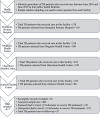Predictors of loss to follow-up among adult tuberculosis patients in Southern Ethiopia: a retrospective follow-up study
- PMID: 35568853
- PMCID: PMC9107690
- DOI: 10.1186/s12889-022-13390-8
Predictors of loss to follow-up among adult tuberculosis patients in Southern Ethiopia: a retrospective follow-up study
Abstract
Background: Loss to follow-up (LTFU) from tuberculosis (TB) treatment and care is a major public health problem as patients can be infectious and also may develop a multi-drug resistant TB (MDR-TB). The study aimed to assess whether LTFU differs by the distance TB patients travelled to receive care from the nearest health facility.
Methods: A total of 402 patient cards of TB patients who received care were reviewed from March 1-30, 2020. The Kaplan-Meir curve with the Log-rank test was used to compare differences in LTFU by the distance travelled to reach to the nearest health facility for TB care. The Cox proportional hazard regression model was used to identify predictors. All statistical tests are declared significant at a p-value< 0.05.
Results: A total of 37 patients were LTFU with the incidence rate of 11.26 per 1000 person-months of observations (PMOs) (95% CI: 8.15-15.53). The incidence rate ratio was 12.19 (95% CI: 5.01-35.73) among the groups compared (those who travelled 10 km or more versus those who travelled less than 10 km). Age ≥ 45 years (aHR = 7.71, 95% CI: 1.72, 34.50), educational status (primary schooling, aHR = 3.54, 95% CI: 1.49, 8.40; secondary schooling, aHR = 2.75, 95% CI: 1.08, 7.03), lack of family support (aHR = 2.80, 95% CI: 1.27, 6.19), nutritional support (aHR = 3.40, 95% CI:1.68, 6.89), ≥ 10 km distance to travel to a health facility (aHR = 6.06, 95% CI: 2.33, 15.81) had significantly predicted LTFU from TB treatment and care.
Conclusions: LTFU from adult TB care and treatment was 12 times higher among those who travelled ≥10 km to reach a health facility compared to those who travelled less. To retain adult TB patients in care and ensure appropriate treatment, health professionals and other stakeholders should give due attention to the factors that drive LTFU. We suggest identifying concerns of older patients at admission and those who travel long distance and establish social support platforms that could help people to complete TB treatment.
Keywords: Adults; Distance to health facility; Loss to follow-up; Southern Ethiopia; Tuberculosis.
© 2022. The Author(s).
Conflict of interest statement
The authors declare that they have no competing interest.
Figures



References
-
- Federal, Ministry of Health, and Ethiopian Public Health Institute. Tuberculosis Prevalence Survey. Addis Ababa; 2011. Availablefrom: https://www.ephi.gov.et/images/downloads/Tuberculosis%20Prevalence%20Sur.... Accessed 17 May 2021.
-
- World Health Organization . Global tuberculosis report. 2015.
-
- World Health Organization . Global tuberculosis report. 2020.
-
- Federal MInistry of Health/Ethiopian Public Health Institute. Implementation Guideline for GeneXpert MTB/RIF Assay in Ethiopia. Addis Ababa; 2014. Available from: https://ephi.gov.et/images/pictures/Implementation%20Guideline%20for%20%.... Accessed 17 May 2021.
-
- Eshetie S, Gizachew M, Dagnew M, Kumera G, Woldie H, Ambaw F, et al. Multidrug resistant tuberculosis in Ethiopian settings and its association with previous history of anti-tuberculosis treatment: a systematic review and meta-analysis. BMC Infect Dis. 2017;17(1):1–12. doi: 10.1186/s12879-017-2323-y. - DOI - PMC - PubMed
Publication types
MeSH terms
LinkOut - more resources
Full Text Sources
Medical

